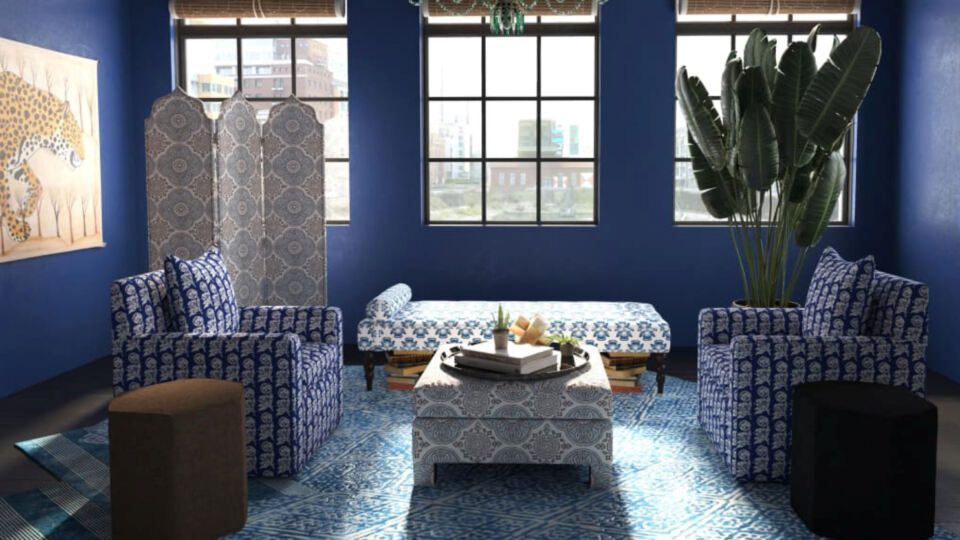Designing a photoshoot for a furniture collection is typically an expensive, logistics-heavy procedure that involves months spent coordinating teams of people, products and locations. Additionally, the end result is a set of 2D imagery that can inspire — but that still doesn’t offer quite the same experience as seeing an actual piece on display in a showroom.
Home furnishing brand Cloth & Company is working with 3D asset creation and management provider All3D to help even small retailers and designers overcome this challenge through the creation of virtual showrooms using 3D rendering software. This removes the cost and complexity of shipping furniture pieces for photoshoots, which is particularly difficult right now due to supply chain issues, as well as the difficulty of getting all the necessary staff in the same place at the same time.
The average photoshoot for a line takes six months to set up, but the brands were able to design the products and create a virtual walkthrough with designer John Robshaw in a fraction of that time. The process also greatly reduced the necessary investment, reducing the cost of bringing the collection to market from tens of thousands to just thousands.
“What’s really cool about this is the speed,” said Meganne Wecker, President and Chief Creative Officer at Skyline Furniture and Founder of Cloth & Company in an interview with Retail TouchPoints. “We brought this to life in about three weeks from the time we discussed even doing a collection to finalizing the walkthrough.”
This approach came naturally to Cloth & Company, which puts technology at the heart of its operation. The retailer designs its collections using 3D models, then utilizes digital printing technology to make all products to order, and ships them to the customer within two weeks, making it a perfect fit as the first consumer-facing brand to create a digital experience with All3D.
“In years gone by, when I would create textiles it would take 90 days and then you had to print 2,000 yards,” said Wecker. “You had to hope that it was going to be a really good seller, so traditionally we would not have done these types of collections unless we had a big retailer tied to it. We’ve done collabs over the years with Target and companies who really can move that kind of volume, but it was unattainable for the smaller retailers of the world. Now that we can print one yard, or zero yards, or 10,000 yards, it really opens up that flexibility for everybody to be able to have these types of collections.”
Modern Technology Makes Digital Experiences Easier and More Accessible
Cloth & Company has experience creating virtual walkthroughs through its sister brand Skyline Furniture, and these have changed to reflect the current mood of Skyline’s customer base. The first walkthrough, which launched in winter 2020, had four different visions including a farmhouse and a California style theme. The second came in 2021, when cooped-up shoppers wanted to get out of their homes, so it featured vacation spots like a cabin and a beach house.
The latest collection is designed to inspire people eager to return to global travel, and the rooms reflect this. The John Robshaw collection is featured in a room with Indian aesthetics, and the three remaining virtual showrooms will focus on Milan, Paris and Mexico. Additionally, the styles of the homes are designed to match their intended audiences.
“John has traditionally been a designer for the high end, and so this is the first collection with more of an affordable price,” said Wecker. “John really envisioned this space to be an apartment and we thought about what that could look like through his lens. We could have modeled these big, beautiful mansions, but what we really wanted is places where people purchasing this type of product might realistically be living.”
Creating the virtual showrooms was a fairly intuitive process. The platform lets creators drag and drop the pieces throughout the space to get the exact look they want, and the creators also can switch between view modes
“I can go in and I can move things around — it’s kind of like playing The Sims,” said Lindsey Pelton, Design Manager at Skyline Furniture in an interview with Retail TouchPoints. “I can see what it looks like from a human eye or from the camera as well. I can walk through this space, and if I want to change the placement of things I can drag them around or rotate them. I can duplicate them to create additional items if we want. It’s really fun and it’s very easy to use.”
In addition to the other benefits, John Robshaw has been able to host the virtual showroom on his own site. These sorts of experiences were once the domain of large retailers with technology budgets to match, but lower IT costs have made it accessible to companies of all sizes.
“A lot of the smaller designers have the ability, if they have a website, to host this type of experience,” said Wecker. “Traditionally, this has been held to the retailers with large budgets who could go out and do big photo shoots or could invest in the 3D technology.”













